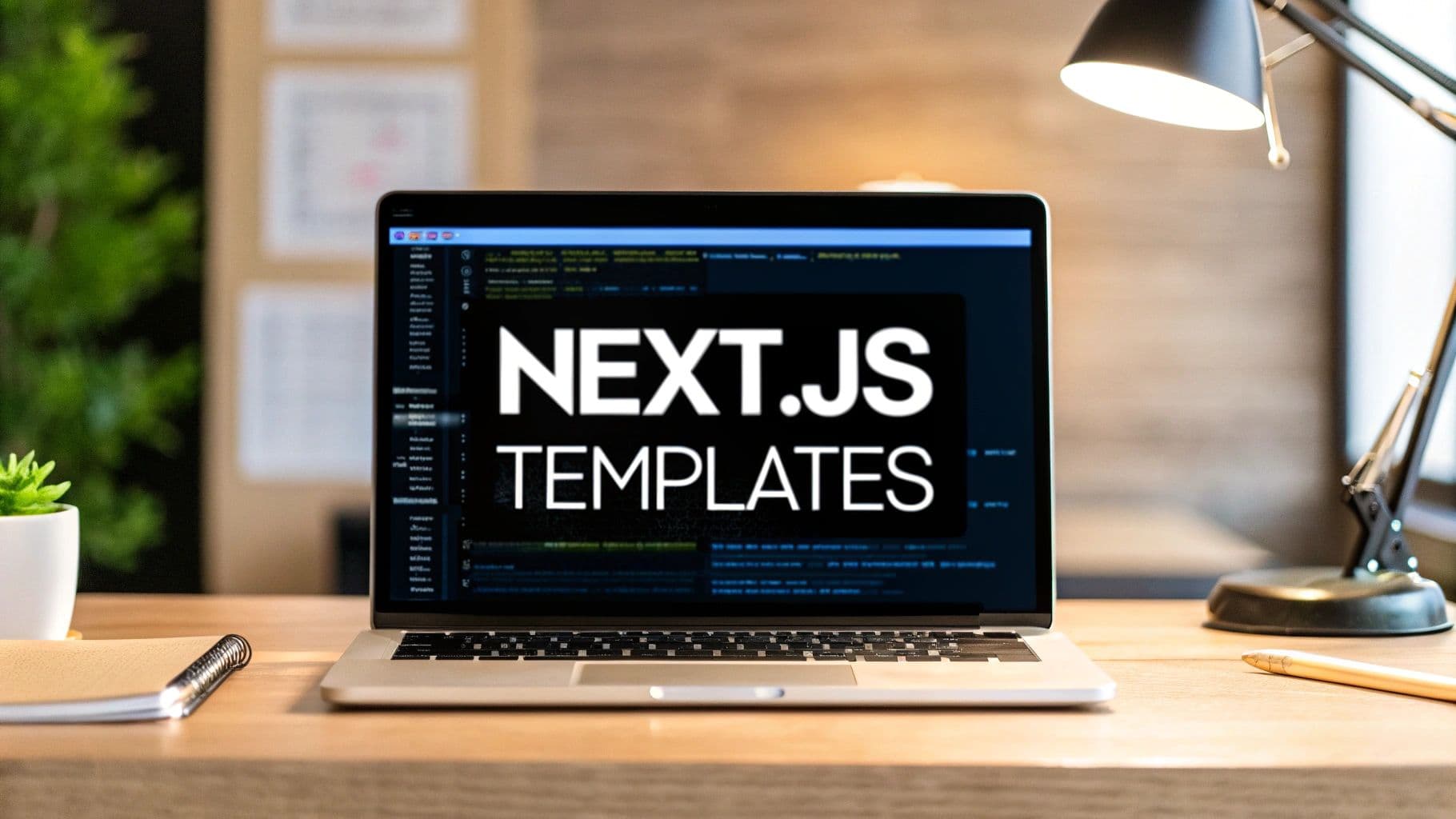next js landing page template
next.js templates
landing page
saas templates
nextjs
Top Next.js Landing Page Templates for SaaS in 2025
Launch Your SaaS Faster with the Perfect Next.js Landing Page
Building a compelling landing page is essential for SaaS success. This list of the top 7 Next.js landing page templates saves you development time and effort. Whether you need a simple marketing site or a complex product showcase, discover the perfect starting point for your next project. Find the ideal Next.js landing page template from pre-built options like Material-UI and Tailwind UI templates, dedicated resources like Nextra Theme Docs and Vercel Templates, purpose-built tools like Next.js Commerce, or comprehensive solutions like AnotherWrapper and Creative Tim Next.js Templates. We'll cover these 7 tools to help you launch faster.
1. AnotherWrapper
AnotherWrapper positions itself as the ultimate AI starter kit for rapidly building and launching micro SaaS projects using Next.js. It aims to drastically reduce development time by providing a comprehensive suite of pre-built components, demo applications, and integrations, allowing developers to focus on the unique aspects of their AI-powered product. This makes it an attractive option for anyone looking to quickly bring an AI-driven idea to market, whether it's a simple utility tool or a more complex application. This "next js landing page template" offering distinguishes itself through its focus on AI integrations, offering a substantial head start compared to building from scratch.

One of AnotherWrapper's key strengths lies in its diverse range of over 12 demo applications. These cover a wide spectrum of AI functionalities, including image generation with DALL·E 3, advanced chatbot development leveraging GPT-4o and Claude 3, PDF question-answering, speech-to-text using Whisper, text-to-speech, and more. This breadth of pre-built examples allows developers to quickly experiment with various AI models and adapt the code to their specific needs, significantly shortening the prototyping phase. For example, if you're building a SaaS product that analyzes documents, the pre-built PDF Q&A demo provides a solid foundation to build upon. Likewise, if you envision an AI-powered chatbot, the included demos offer a starting point, allowing you to customize the conversation flow and integrate with your chosen AI model. This feature-rich approach allows developers to bypass the complexities of setting up individual integrations and jump straight into building the core functionality of their product.
AnotherWrapper streamlines the development process further through its seamless integration with Supabase. This covers essential backend services, including authentication, database management, and vector embeddings, crucial for many AI applications. This pre-configured setup eliminates the need for developers to manage separate databases and authentication systems, freeing up valuable time and resources. The inclusion of built-in support for payments (via LemonSqueezy and Stripe), analytics, email services, and even programmatic SEO further simplifies the process of building a fully functional SaaS product. This integrated approach allows even solo developers to handle the complexities of running a full-fledged business, from development and deployment to marketing and monetization.
Beyond its functional components, AnotherWrapper prioritizes aesthetics and user experience. It offers over 40 pre-built UI components, 5 landing page variants, and more than 40 TailwindCSS themes, all with full TypeScript support. This comprehensive collection allows developers to rapidly create visually appealing and responsive web applications without needing extensive front-end expertise. The availability of multiple landing page templates further accelerates the go-to-market process, allowing developers to quickly establish an online presence and start acquiring users.
For pricing, AnotherWrapper operates on a one-time license model starting at $249, providing lifetime access and supporting unlimited product launches. Enterprise plans are also available for larger teams. While this might be a steeper investment compared to free open-source alternatives, the comprehensive nature of the toolkit, combined with the significant time savings and included infrastructure, can justify the cost, especially for businesses aiming to launch quickly and scale efficiently.
However, it's important to note that AnotherWrapper is optimized for Next.js and TypeScript. While this combination offers benefits in terms of performance and maintainability, it does require some familiarity with these technologies. Complete beginners may face a learning curve.
Overall, AnotherWrapper provides a powerful and efficient solution for building AI-driven micro SaaS products with Next.js. Its extensive library of demos, seamless integrations, and focus on rapid development make it a compelling choice for individuals and teams looking to leverage the power of AI in their projects. From aspiring entrepreneurs to seasoned developers, AnotherWrapper offers a streamlined path to bring innovative AI solutions to life. You can explore further details and purchase a license on their website: https://anotherwrapper.com
2. Nextra Theme Docs
Nextra stands out as a compelling option for those seeking a streamlined and efficient approach to building landing pages with Next.js, especially if your project leans towards documentation or showcasing technical information. It's more than just a theme; it's a full-fledged documentation framework built on top of Next.js. This means you benefit from the performance and SEO advantages of Next.js while leveraging Nextra's purpose-built features for creating beautiful, content-rich landing pages. This makes it particularly attractive for projects that blur the line between a traditional landing page and a documentation hub, like SaaS products, open-source projects, or technical showcases. If you need a next js landing page template, Nextra deserves serious consideration.
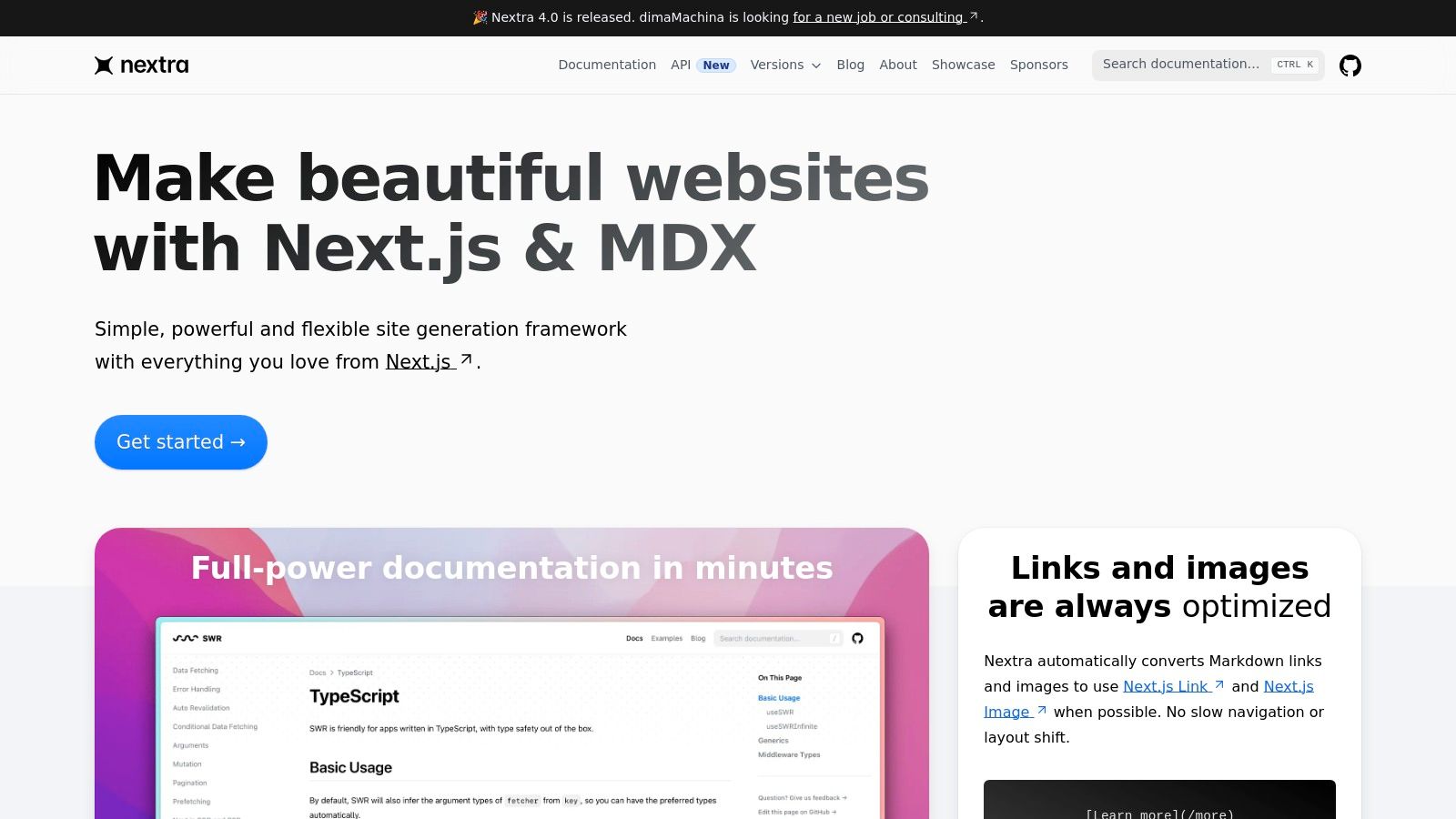
One of Nextra's most significant strengths is its simplicity. The "zero-config" philosophy means you can get a polished landing page up and running incredibly quickly with sensible defaults. This is a boon for developers, especially those new to Next.js, as it reduces the initial setup hurdle. Nextra's built-in MDX support makes content creation a breeze. MDX allows you to seamlessly blend Markdown with JSX, enabling you to embed interactive components, import data, and customize the look and feel of your landing page without resorting to complex templating systems. This is a huge advantage for developers and content creators alike. Imagine showcasing code examples with syntax highlighting directly within your landing page copy, or embedding interactive demos of your product—MDX empowers you to do all of this with remarkable ease.
Nextra's focus on documentation doesn't mean it lacks the features you'd expect from a modern landing page template. It offers a sleek, modern design out of the box, with excellent typography and responsive layouts optimized for all devices. The built-in dark and light theme toggle, complete with system preference detection, enhances user experience. And for projects with substantial content, the full-text search functionality powered by FlexSearch ensures visitors can quickly find what they're looking for.
From a technical perspective, Nextra leverages the power of Next.js, ensuring excellent performance and SEO benefits. Automatic sitemap generation further enhances SEO, making it easier for search engines to index your content. The fact that Nextra is free and open-source, under the MIT license, adds to its appeal, especially for cost-conscious developers and open-source enthusiasts.
Compared to other Next.js landing page solutions, Nextra distinguishes itself with its documentation-centric approach. While other tools might offer more extensive customization options for visually driven landing pages, Nextra excels in presenting information-rich content clearly and efficiently. If your landing page needs to serve as a central hub for both marketing and documentation, Nextra hits the sweet spot.
Getting started with Nextra is remarkably simple. Its zero-configuration nature means you can often have a basic landing page running in minutes. Simply install the package via npm or yarn, create a few Markdown files, and you're ready to go. For more advanced customizations, some React and Next.js knowledge will be beneficial, allowing you to tap into the underlying framework's power.
While Nextra's focus on documentation is a strength, it can also be a limiting factor. Heavy customization beyond the provided defaults might require deeper code modifications. Also, if your landing page is purely marketing-focused and doesn't require extensive documentation features, other Next.js landing page solutions might offer more design flexibility.
For independent developers, hobbyists, startups, freelance agencies, and anyone working on documentation-heavy projects, Nextra offers an efficient and elegant solution for building landing pages with Next.js. Its ease of use, performance benefits, and rich feature set make it a strong contender for your next project. The project is actively maintained with a vibrant community, ensuring continued development and support. You can find more information and documentation on their official website: https://nextra.site.
3. Tailwind UI
Building a landing page that converts requires a delicate balance of aesthetics and functionality. For those seeking a premium, polished solution built with the popular Tailwind CSS framework, Tailwind UI offers a compelling suite of Next.js landing page templates. These pre-built templates provide a robust starting point for projects of all sizes, allowing developers to leverage professionally designed components and layouts to accelerate their development workflow. Whether you're a seasoned developer or just starting with Next.js, Tailwind UI provides a powerful toolkit for creating high-performing landing pages. This makes it a strong contender for anyone looking for a professional and customizable Next.js landing page template.
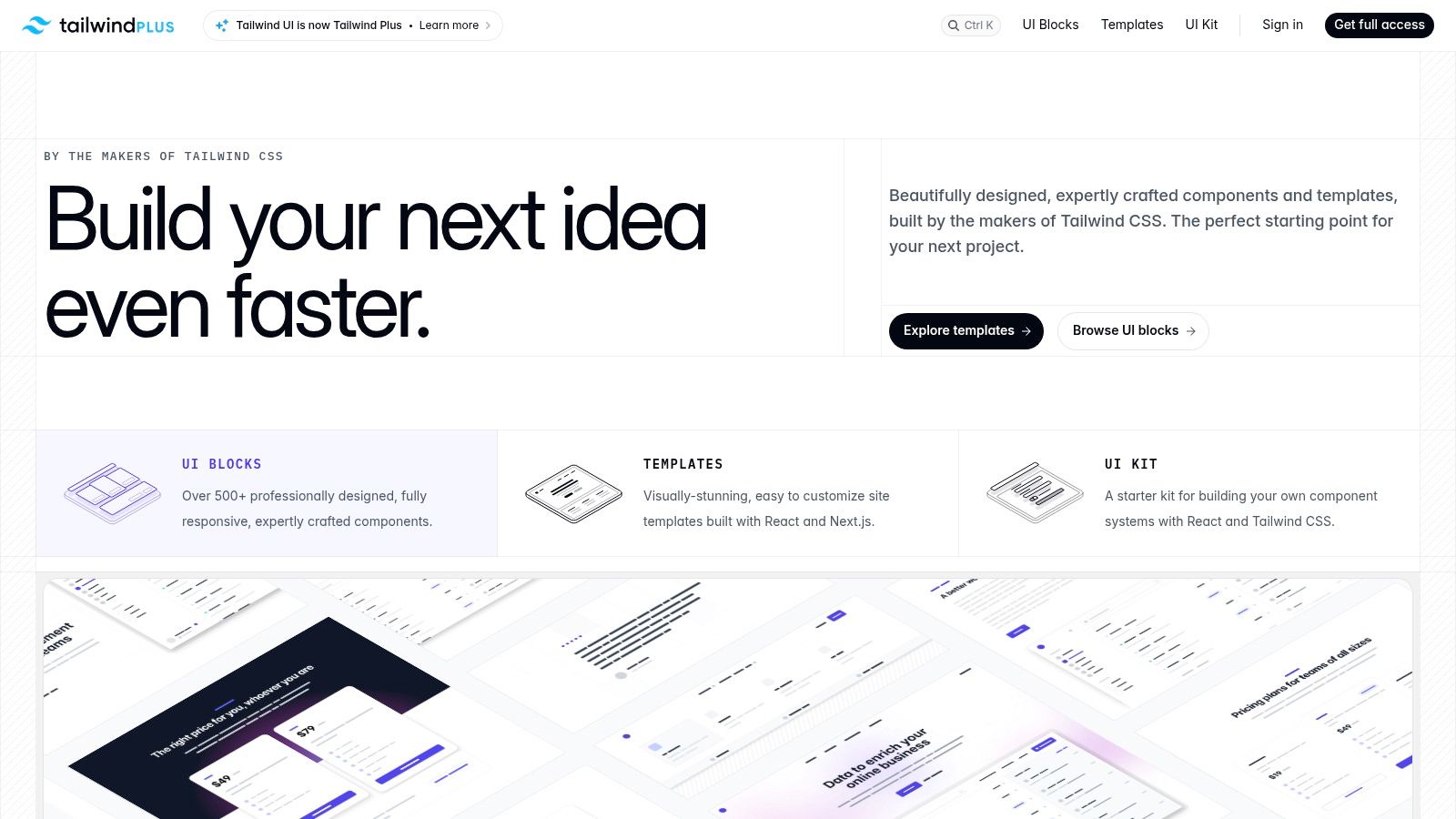
Tailwind UI stands out with its extensive library of over 500 professionally designed components. This comprehensive collection allows you to mix and match various elements, from hero sections and testimonials to pricing tables and call-to-actions, to construct a landing page that perfectly aligns with your brand and messaging. The templates are thoughtfully categorized for different industries and use cases, ranging from SaaS startups and e-commerce platforms to marketing agencies and personal portfolios. This allows you to quickly find a template that resonates with your specific needs and target audience. Moreover, the included React and Next.js code examples facilitate seamless integration and customization within your existing projects.
One of the most significant advantages of using Tailwind UI is the sheer speed and efficiency it brings to the development process. Instead of building every component from scratch, you can leverage the pre-built components and layouts to significantly reduce development time. This is particularly beneficial for startups and freelancers working under tight deadlines or with limited resources. The mobile-first responsive design approach ensures that your landing page looks and performs flawlessly across all devices, from desktops to smartphones. This is crucial in today's mobile-centric world, where a significant portion of your traffic is likely to come from mobile devices.
For developers already familiar with Tailwind CSS, customizing these templates is a breeze. The underlying code is clean, well-structured, and easy to understand. However, it's worth noting that some familiarity with Tailwind CSS is recommended to take full advantage of the customization options. While Tailwind UI offers excellent documentation and examples, direct customer support for template usage is not provided. This might be a drawback for those completely new to the framework or who prefer dedicated support channels.
Comparing Tailwind UI with other Next.js landing page template providers, the key differentiator is the quality and comprehensiveness of its component library. While other options might offer free or cheaper alternatives, they often lack the breadth and depth of Tailwind UI's offering. This translates to more design flexibility and less time spent on custom development.
Implementing a Tailwind UI template is straightforward. After purchasing the desired package, you'll receive access to the template files. You can then integrate these files into your Next.js project and start customizing the content, styling, and functionality to match your specific requirements. The provided documentation guides you through the process, ensuring a smooth and hassle-free setup experience.
However, the premium pricing, starting at $249, can be a barrier to entry for some, especially individual developers and hobbyists. While the value proposition is undeniable, particularly for professional agencies and businesses, the cost might be prohibitive for smaller projects with limited budgets. Consider the long-term benefits of using a high-quality template against the upfront cost. The time saved in development and the professional look and feel of the finished product can often justify the investment.
In conclusion, Tailwind UI offers a powerful and efficient way to build stunning Next.js landing pages. Its extensive component library, coupled with its focus on Tailwind CSS and Next.js, makes it a compelling choice for developers seeking a premium and customizable solution. While the premium pricing and requirement of Tailwind CSS knowledge might be considerations, the quality, comprehensiveness, and time-saving benefits of Tailwind UI make it a valuable asset in any web developer's toolkit. For more details and to explore their offerings, visit the official website at https://tailwindui.com.
4. Vercel Templates
Vercel, the platform built for frontend developers, offers a treasure trove of free Next.js landing page templates through their official template gallery. These templates provide a fantastic starting point for building high-performing landing pages, especially for those seeking rapid deployment and seamless integration with the Vercel ecosystem. Whether you're a startup founder validating a new idea, an independent developer crafting a portfolio, or a freelance agency building a client's online presence, Vercel templates can significantly accelerate your development process. They deserve a prominent spot in this list due to their ease of use, official backing, and optimization for performance. These next js landing page template resources can be immensely helpful for various projects.
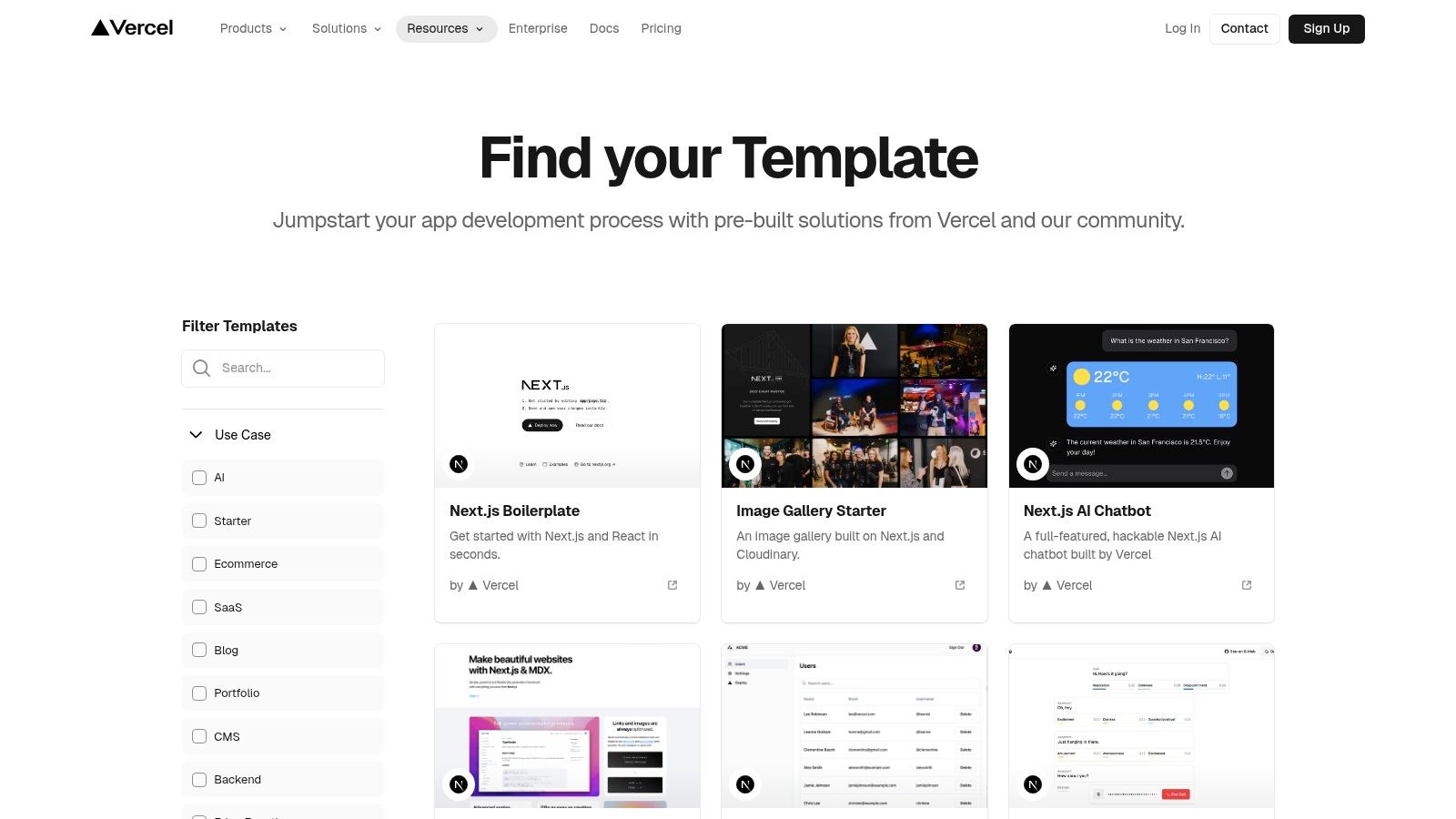
The templates are maintained by both the Next.js team and the wider community, ensuring they adhere to current best practices and are continually optimized for Vercel's deployment platform. This collaborative approach results in a collection of robust and reliable templates that cover a broad spectrum of use cases. You'll find templates tailored for portfolios, e-commerce storefronts, blog platforms, and classic corporate landing pages, among others. This diverse range allows developers to quickly find a suitable foundation and focus on customizing the content and design to match their specific needs. If you're looking to validate your startup idea quickly, a tool like those found at Learn more about Vercel Templates might prove beneficial.
One of the most significant advantages of using Vercel templates is the one-click deployment process directly to the Vercel platform. This streamlined workflow removes the complexities often associated with deploying web applications, enabling you to get your landing page live in minutes. Furthermore, these templates are inherently optimized for Core Web Vitals, crucial performance metrics that impact both search engine rankings and user experience. This optimization ensures that your landing page loads quickly and provides a smooth, responsive experience for visitors.
Beyond deployment and performance, Vercel templates boast integration with popular CMS platforms, allowing you to easily manage and update your landing page content. They also include built-in analytics and monitoring tools, empowering you to track key metrics and gain valuable insights into user behavior. Advanced features such as support for edge functions and API routes further enhance the functionality and flexibility of these templates, making them suitable for more complex projects as well.
While the free nature and ease of use of Vercel templates are undeniable advantages, they do come with some limitations. The design variety available in the free tier may not be as extensive as some premium template marketplaces. Furthermore, the out-of-the-box customization options are relatively basic, and achieving a unique look and feel might require additional styling and development work. This means that while the template provides a solid foundation, developers should be prepared to invest some time in tailoring the design to their brand or client's requirements.
Here's a summarized overview of the pros and cons:
Pros:
- Completely free to use
- Official Next.js team support and community contributions
- Seamless Vercel integration with one-click deployment
- Optimized for Core Web Vitals and overall performance
- Regular updates leveraging the latest Next.js features
Cons:
- Limited design customization options out of the box
- Less design variety compared to paid alternatives
- Might necessitate additional styling and development for unique branding
Overall, Vercel Templates present an exceptional resource for developers seeking a quick, efficient, and cost-effective way to build Next.js landing pages. The seamless Vercel integration, performance optimizations, and readily available integrations make them a powerful tool for a variety of projects, from simple portfolios to complex marketing campaigns. While the design limitations are worth considering, the benefits often outweigh the drawbacks, especially for projects with tight deadlines and budgets. For a robust and reliable foundation for your next Next.js landing page project, exploring Vercel's template gallery is an excellent place to start. You can explore the available templates at https://vercel.com/templates.
5. Material-UI (MUI) Templates
If you're seeking a polished and professional look for your Next.js landing page, Material-UI (MUI) templates offer a compelling solution. Built upon Google's Material Design principles, these templates provide a modern and clean aesthetic combined with a rich set of pre-built components and advanced theming options. This makes MUI an excellent choice for businesses, startups, and individual developers aiming to create high-quality landing pages that adhere to established design standards and offer excellent accessibility out-of-the-box. They are particularly well-suited for projects where consistent design patterns and a focus on user experience are paramount. Whether you're building a landing page for a SaaS product, an e-commerce store, or a portfolio website, MUI provides a solid foundation to accelerate your development process.
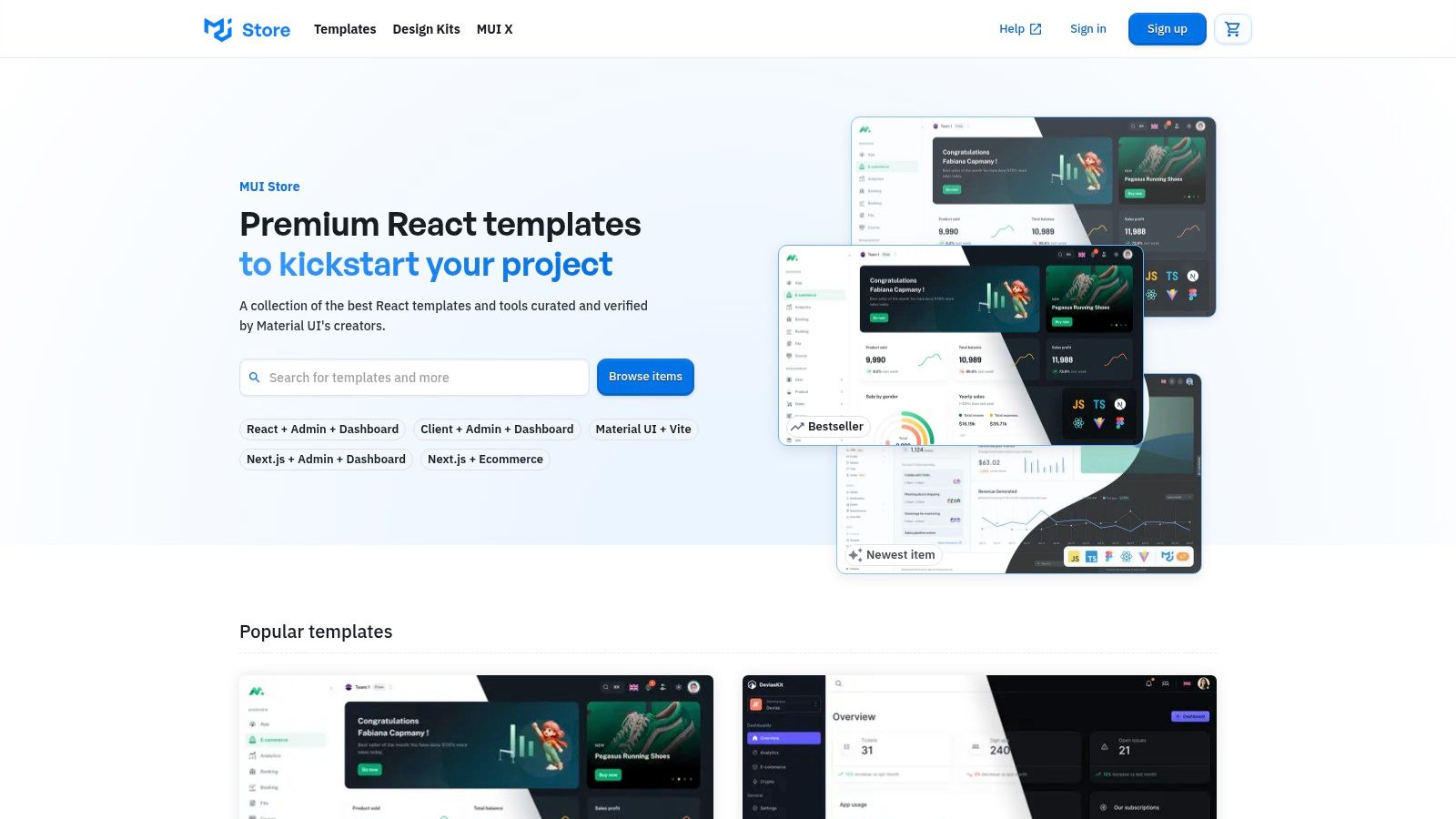
MUI offers a wide range of ready-made next js landing page templates, both free and premium. Free templates provide a great starting point for basic projects, while premium templates offer more advanced features, layouts, and customization options. These premium templates, available on the MUI store (https://mui.com/store), cater to various niches and industries, allowing you to select a design that best suits your specific needs. Prices for premium templates vary but typically range from around $50 to $200, depending on the complexity and features included. This upfront cost can save significant development time compared to building a landing page from scratch.
One of MUI's core strengths is its comprehensive component library. From buttons and navigation bars to data tables and form elements, MUI provides pre-built components that follow Material Design guidelines. This not only speeds up development but also ensures a consistent user interface across your landing page. Furthermore, MUI’s advanced theming capabilities allow you to customize the look and feel of your landing page to match your brand identity. You can easily adjust colors, typography, and spacing to create a truly unique design.
For developers who prioritize type safety, MUI provides excellent TypeScript support. This helps catch potential errors early in the development process, leading to more robust and maintainable code. The built-in accessibility (a11y) features of MUI are another significant advantage. These features ensure that your landing page is usable by people with disabilities, adhering to web accessibility standards like WCAG. This inclusive approach is not just ethically sound but also crucial for reaching a wider audience. MUI also benefits from a large and active community, providing ample resources, tutorials, and support for developers.
While MUI offers numerous advantages, it's essential to consider the potential drawbacks. The biggest one is the cost associated with premium templates. While free templates are available, they may lack the advanced features and customization options offered by their paid counterparts. Additionally, the Material Design aesthetic, while modern and clean, may not be suitable for every brand. If your brand identity requires a highly customized or unconventional design, MUI might not be the ideal choice. Finally, compared to more lightweight alternatives, MUI can introduce a larger bundle size, which can potentially impact page load times.
To get started with an MUI Next.js landing page template, you'll need a basic understanding of React and Next.js. Once you've chosen a template (free or premium), you can install it using npm or yarn. MUI provides detailed documentation and tutorials to guide you through the setup process. From there, you can customize the template to fit your specific content and branding. You can leverage MUI’s theming options to tailor the visual style and utilize the extensive component library to build out the functionality of your landing page.
Compared to other popular options like Tailwind CSS or Bootstrap, MUI provides a more opinionated approach to styling and layout, offering a pre-defined design system based on Material Design. While this can be advantageous for achieving a consistent and polished look quickly, it can also limit flexibility for highly customized designs. Tailwind, on the other hand, offers a more utility-first approach, allowing for granular control over styling but requiring more manual configuration. Bootstrap offers a middle ground, providing pre-built components and styling options while still allowing for a reasonable degree of customization. The best choice depends on your specific project requirements and design preferences.
6. Creative Tim Next.js Templates
When building a landing page with Next.js, a pre-built template can significantly accelerate the development process. Creative Tim offers a diverse collection of premium Next.js landing page templates designed to cater to a wide array of needs. These templates stand out for their stunning visual designs, comprehensive UI kits, and extensive customization options, making them a valuable asset for anyone looking to create a high-impact online presence. Whether you're an independent developer, a startup founder, or a seasoned agency professional, Creative Tim has something to offer.

Creative Tim's Next.js templates shine due to their focus on creative layouts and modern aesthetics. They provide more than just a basic structure; they offer a polished and professional starting point, enabling you to launch your landing page quickly and efficiently. They are especially advantageous for projects demanding a unique and visually appealing design. The availability of multiple color schemes and layout variations allows for easy branding and customization to fit specific project requirements. Beyond aesthetics, these templates come packed with a comprehensive UI kit, often including over 100 pre-built components. This allows developers to easily drag and drop elements, saving considerable development time and reducing the need for coding from scratch. Think of it as having a toolbox full of ready-to-use, stylish building blocks for your website.
These templates offer a robust foundation with multiple demo pages and pre-built sections for various purposes, like showcasing features, testimonials, pricing plans, and contact forms. This allows users to visualize how different sections can be integrated and provides inspiration for building a comprehensive landing page. Furthermore, integration with popular development tools streamlines the development workflow, ensuring a seamless experience from design to deployment. For instance, many templates are compatible with tools like Vercel, making deployment a breeze. The detailed documentation and video tutorials provided by Creative Tim are invaluable, especially for those new to Next.js or the specific template. These resources guide users through the setup process, customization options, and troubleshooting, minimizing the learning curve and empowering users to make the most of the template’s features. You can Learn more about Creative Tim Next.js Templates.
While Creative Tim’s Next.js templates offer significant advantages, it's important to consider the potential drawbacks. The templates come with a premium price tag, ranging from $59 to $299 depending on the features and complexity. This cost might be a barrier for some individual developers or small businesses with limited budgets. While the templates offer extensive customization options, there is still a learning curve associated with understanding the template’s structure and making modifications. This might require some familiarity with Next.js and related technologies. Lastly, some of the designs might be considered too elaborate or visually busy for projects that require a more minimalist approach. It's important to choose a template that aligns with the specific needs and aesthetic preferences of your project.
In comparison to free or open-source Next.js landing page templates, Creative Tim provides a higher level of polish, design quality, and comprehensive features. The included UI kits and pre-built components significantly expedite development, making them a worthwhile investment for projects where time-to-market is critical. For startups or businesses looking to create a professional and visually compelling landing page quickly, Creative Tim offers a robust and efficient solution.
Implementing a Creative Tim Next.js template is generally straightforward. After purchasing the template, you'll receive access to the source code and documentation. You'll need to have Node.js and npm (or yarn) installed on your system. The documentation typically provides step-by-step instructions on how to set up the project, install dependencies, and customize the template to your specific needs. Familiarity with Next.js and React will be beneficial for making more substantial customizations.
Creative Tim’s Next.js templates deserve a place on this list because they offer a powerful combination of beautiful design, extensive features, and comprehensive documentation. They provide a valuable starting point for building high-quality landing pages, saving developers significant time and effort. While the premium price point may be a factor, the value proposition of a polished, professional design, coupled with extensive customization options, makes these templates a compelling option for those serious about creating impactful online experiences. The ongoing support and regular updates ensure that the templates remain current and compatible with the latest Next.js features, making them a long-term investment in your project's success.
7. Next.js Commerce
Next.js Commerce is a powerful open-source e-commerce template meticulously crafted for building high-performance online stores and dynamic product landing pages. Developed by the Vercel team, the same team behind Next.js itself, this template leverages the latest Next.js features, including Incremental Static Regeneration (ISR), Static Site Generation (SSG), and edge functions, to deliver a blazing-fast and scalable e-commerce experience. It offers a robust foundation for businesses looking to establish a strong online presence and provides a streamlined development process for creating engaging and effective product showcases. For those seeking a dedicated solution for building an online store using a next js landing page template, Next.js Commerce is a strong contender.

Next.js Commerce distinguishes itself through its e-commerce-centric features. It provides pre-built components and layouts specifically designed for online stores, streamlining the development process. Imagine needing a product grid, a shopping cart component, or a checkout flow. Instead of building these from scratch, you can leverage the readily available components in Next.js Commerce, saving valuable time and resources. The template seamlessly integrates with popular e-commerce platforms like Shopify and BigCommerce, allowing you to connect your existing store or easily set up a new one. This integration simplifies inventory management, order processing, and other crucial backend operations. Furthermore, Next.js Commerce excels in performance optimization through advanced image optimization and lazy loading, ensuring fast page load times and a smooth user experience. Built-in SEO optimization for product pages helps improve your search engine rankings and drive organic traffic to your store. Finally, the template includes integrated payment gateways and pre-built checkout flows to facilitate seamless transactions.
One of the significant advantages of Next.js Commerce is that it's free and open-source, making it accessible to developers of all levels and budgets. This allows for community contributions and ensures continuous improvement of the template. The active development by the Vercel team guarantees ongoing support and updates, keeping the template up-to-date with the latest Next.js advancements. This is particularly valuable for staying ahead of the curve and benefiting from new features and performance improvements. You can learn more about Next.js Commerce and its growing community.
While Next.js Commerce provides a robust platform for e-commerce, it's important to consider its primary focus. If your landing page needs are simple and don't require extensive e-commerce functionality, the template might be overkill. Implementing the full functionality requires integration setup with an e-commerce platform, which may introduce some complexity for smaller projects. However, for those seeking a high-performance, feature-rich solution specifically for next js landing page template within an e-commerce context, Next.js Commerce is a valuable tool.
For implementation, start by cloning the Next.js Commerce repository and following the provided setup instructions. You'll need to configure your chosen e-commerce platform integration and customize the template to match your brand and product offerings. Familiarity with Next.js and React is recommended for smooth implementation.
Compared to building a custom e-commerce solution from scratch, Next.js Commerce provides a significant head start, accelerating development and reducing costs. It offers a well-structured and optimized foundation, allowing developers to focus on customizing the user interface and adding unique features rather than reinventing the wheel. For independent developers and hobbyists, this provides a professional-grade template to launch their online store quickly. For startup founders and entrepreneurs, it offers a scalable and cost-effective solution. Freelance agencies and consultants can leverage the template to deliver high-quality e-commerce projects to their clients. Product managers and technical leads can use it as a solid foundation for their e-commerce initiatives. And even AI enthusiasts and prototypers can leverage its robust features to build innovative e-commerce experiences.
In conclusion, Next.js Commerce empowers developers to build high-performing and visually appealing online stores with minimal effort. Its e-commerce focus, performance optimizations, and active development make it a compelling option for businesses looking to establish or enhance their online presence. While its complexity might be overkill for simple landing pages, its benefits far outweigh the drawbacks for those seeking a comprehensive next js landing page template tailored to e-commerce needs. The platform is available at https://nextjs.org/commerce.
Next.js Landing Page Templates Comparison
| Product | Core Features & Integration ✨ | User Experience & Quality ★★★★☆ | Value & Pricing 💰 | Target Audience 👥 | Unique Selling Points 🏆 |
|---|---|---|---|---|---|
| AnotherWrapper 🏆 | 12+ AI demo apps, Supabase auth & DB, GPT-4o, DALL·E, Claude 3 | Enterprise-grade, 40+ UI components, Tailwind themes | $249 one-time, lifetime, unlimited products | Devs, founders, freelancers, AI enthusiasts | All-in-one AI SaaS kit, rapid launch, extensive demos |
| Nextra Theme Docs | MDX support, dark/light mode, full-text search, SEO | Clean, modern docs focus, excellent typography | Free, open-source | Documenters, SaaS, OSS projects | Zero config, Next.js optimized, active community |
| Tailwind UI | 500+ components, multiple layouts, Tailwind CSS, React support | Professional design, production-ready templates | From $249 premium | Web devs, SaaS startups, designers | Huge component library, high customization |
| Vercel Templates | One-click deploy, CMS integration, Core Web Vitals optimized | Basic but performant, official Next.js support | Free | Next.js devs, startups, portfolios | Official templates, seamless Vercel deployment |
| Material-UI (MUI) Templates | Material Design, a11y compliance, theming, TypeScript support | Professional, accessible, strong ecosystem | Premium paid licenses | Businesses needing Material Design consistency | Accessibility focus, large community & tools |
| Creative Tim Next.js | 100+ components, multiple color schemes & demos, docs/videos | Unique visuals, extensive customization | $59-$299 premium | Agencies, startups, creative pros | Creative design, full UI kits, rich documentation |
| Next.js Commerce | E-commerce layouts, Shopify & BigCommerce integration | Highly optimized for e-commerce | Free, open-source | E-commerce businesses, online stores | E-commerce focused, payment integration, Vercel built |
Ready to Elevate Your SaaS Landing Page?
Choosing the right Next.js landing page template is a crucial first step towards a successful SaaS launch. We've explored a diverse range of options, from the streamlined simplicity of Nextra Theme Docs and Vercel Templates to the robust component libraries of Material-UI (MUI) and the professionally designed offerings from Creative Tim and Tailwind UI. We even touched on a specialized solution, Next.js Commerce, for e-commerce focused projects. Remember to consider your project's specific requirements, budget, and technical expertise when selecting the best fit. Whether you’re a seasoned developer or just starting out, there's a perfect Next.js landing page template waiting for you.
Creating high-quality landing pages also demands compelling visuals that capture attention and communicate your value proposition effectively. Transform your strategy with dynamic videos by leveraging resources like text to video AI from revid.ai. This can be a particularly efficient way to generate engaging content for your newly created landing page.
Implementing any of these tools can significantly streamline your development process, allowing you to focus on what truly matters: building a product your users will love. Pick the template that resonates with your vision, and get ready to convert visitors into loyal customers! Need a powerful, yet easy-to-use solution to kickstart your Next.js landing page? Check out AnotherWrapper, a comprehensive platform designed to simplify your development workflow and help you create stunning, high-performing Next.js based landing pages.
Fekri

